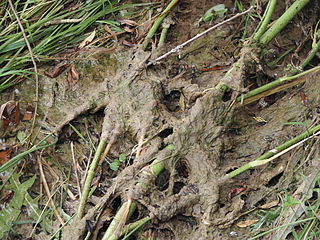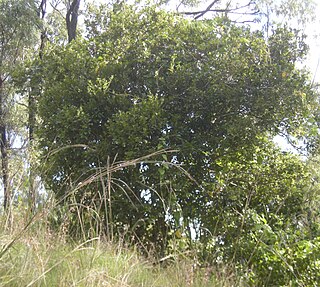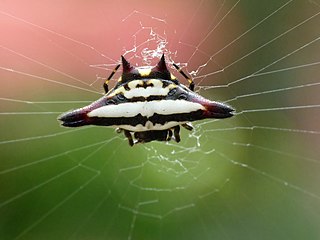
The sap beetles are a family (Nitidulidae) of beetles.

Fred Gannon Rocky Bayou State Park is a Florida State Park located on the northwestern coast of the U.S. state of Florida, southeast of Niceville. The address is 4281 Highway 20. Native American middens and artifacts can be seen throughout the park.

Didymosphenia geminata, commonly known as didymo or rock snot, is a species of diatom that produces nuisance growths in freshwater rivers and streams with consistently cold water temperatures and low nutrient levels. It is native to the northern hemisphere, and considered an invasive species in Australia, Argentina, New Zealand, and Chile. Even within its native range, it has taken on invasive characteristics since the 1980s. It is not considered a significant human health risk, but it can affect stream habitats and sources of food for fish and make recreational activities unpleasant. This microscopic alga can be spread in a single drop of water.

Diospyros geminata is a small tree or shrub of dry rainforest, gallery forest and sub tropical rainforest of Australia and New Guinea.

Quercus geminata, commonly called sand live oak, is an evergreen oak tree native to the coastal regions of the subtropical southeastern United States, along the Atlantic Coast from southern Florida northward to southeastern Virginia and along the Gulf Coast westward to southern Mississippi, on seacoast dunes and on white sands in evergreen oak scrubs.
Mattesia is a genus of parasitic alveolates of the phylum Apicomplexa. Species in this genus infect insects.
Nola geminata is a moth in the family Nolidae. It was described by Mabille in 1899. It is found in Madagascar.
Angadenia is a genus of plant in family Apocynaceae first described as a genus in 1878. It is native to Florida and the West Indies.
- Angadenia berteroi(A.DC.) Miers - Florida, Bahamas, Cuba, Hispaniola, Turks & Caicos Islands
- Angadenia lindeniana(Müll.Arg.) Miers - Cuba, Hispaniola, Jamaica

Sybra is a genus of beetles in the family Cerambycidae, containing the following species:
Niphopterolophia geminata is a species of beetle in the family Cerambycidae, and the only species in the genus Niphopterolophia. It was described by Stephan von Breuning in 1964.

Bradinopyga geminata is a species of dragonfly in the family Libellulidae known commonly as the granite ghost. It is native to India, Sri Lanka and Thailand, where it is a common and widespread species.

Sybra umbratica is a species of beetle in the family Cerambycidae. It was described by Pascoe in 1865.

Sybra ordinata is a species of beetle in the family Cerambycidae. It was described by Bates in 1873.
Sybra pascoei is a species of beetle in the family Cerambycidae. It was described by Lameere in 1893.
Eupterote geminata is a moth in the family Eupterotidae. It was described by Francis Walker in 1855. It is found in India and Sri Lanka.

Gasteracantha geminata is a species of spider of the genus Gasteracantha, found in India and Sri Lanka. It is known as the oriental spiny orb-weaver.
Nymphoides geminata, commonly known as entire marshwort, is an aquatic plant of the family Menyanthaceae native to eastern Australia.

Notoaeschna geminata is a species of dragonfly in the family Telephlebiidae, known as the northern riffle darner. It is endemic to eastern Australia, occurring north of the Hunter River, New South Wales, where it inhabits rapid streams.

Stelidota geminata, the strawberry sap beetle, is a species of sap-feeding beetle in the family Nitidulidae. It is found in Central America, North America, Oceania, and South America.
Odontadenia geminata is a species of plant in the family Apocynaceae. It is found in the 3 Guianas, Venezuela, Colombia, Ecuador, Peru, Bolivia and North Brazil.












